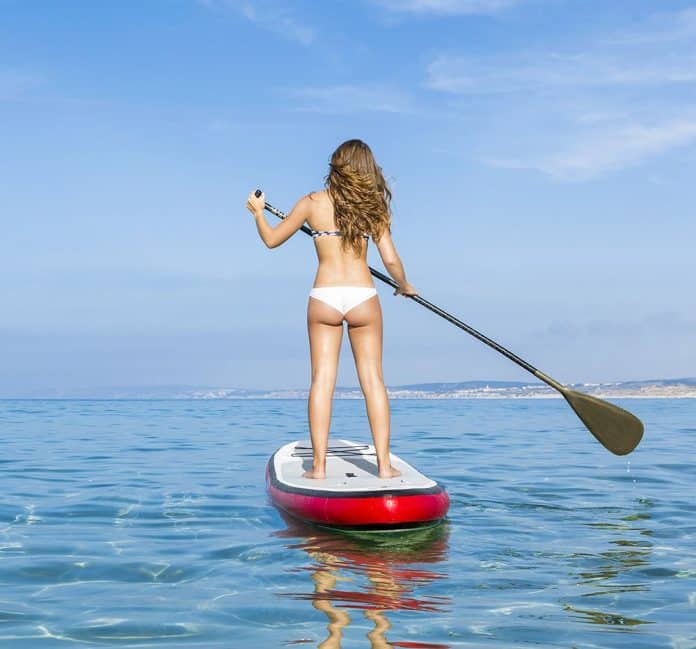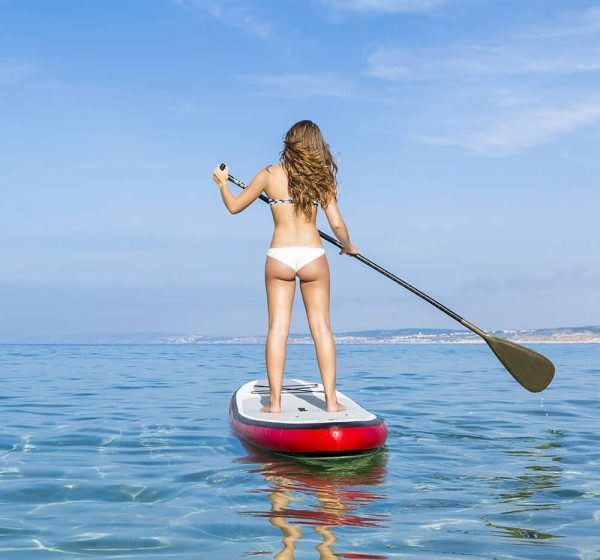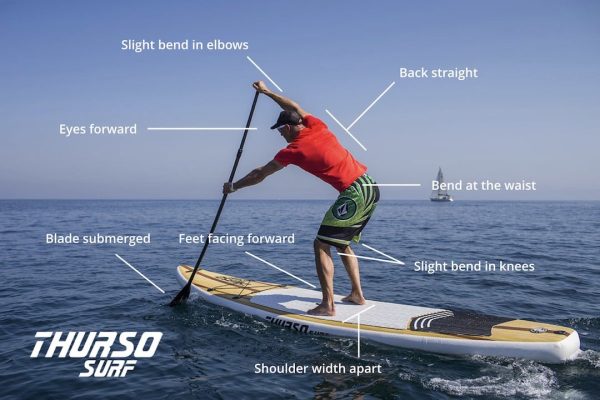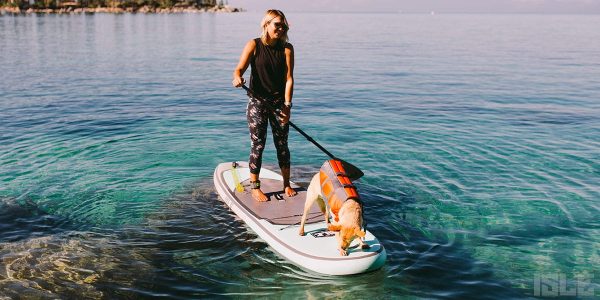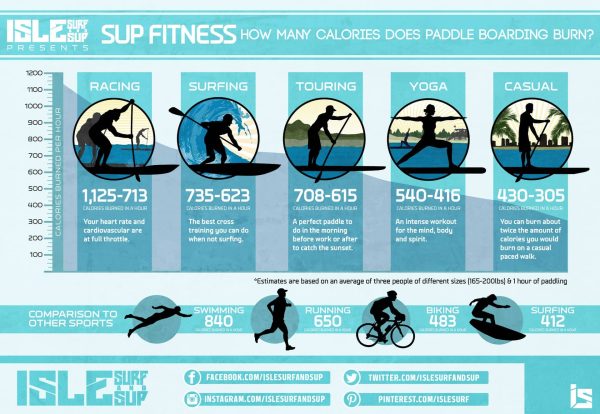Suppose you’ve ever found yourself by the coast, watching people glide effortlessly across the water on what appears to be a glorified surfboard while effortlessly paddling. In that case, you might have wondered, “What does SUP stand for paddleboard?”
Well, wonder no more, as we’re here to shed some light on this famous water sport’s intriguing acronym.
So, let’s get ready to uncover the secret behind SUP and unveil the world of paddleboarding!
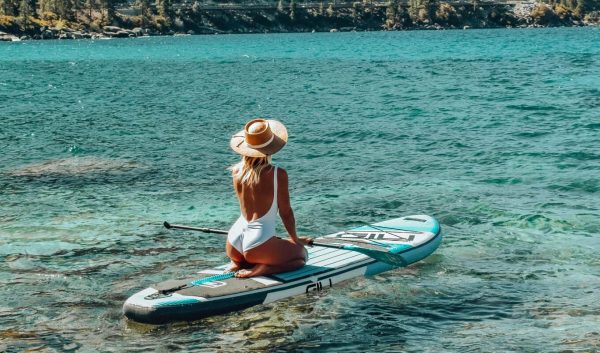
History of Stand-Up Paddleboarding
Stand-up paddleboarding, more commonly known as SUP, is a water sport with a rich history stretching centuries. Originating in the Pacific Islands, SUP is believed to have first been practiced by ancient Polynesians as a means of transportation and fishing. These early paddleboards were often carved from native wood and featured a rounded nose and a long, narrow shape.
Origin of SUP
The exact origin of SUP is challenging to pinpoint, as it was practiced in various forms by different cultures across the Pacific Islands. However, it is widely believed that the Polynesians pioneered stand-up paddleboarding. They used paddleboards, known as “olo” boards, for various purposes, including navigating rough waters and catching fish in shallow areas. This ancient practice laid the foundation for the modern sport of SUP.
Evolution and Popularity of SUP
In recent decades, SUP has experienced a resurgence in popularity and has evolved from a traditional means of transportation into a full-fledged sport. The modern history of SUP can be traced back to the 1940s when Waikiki beach boys in Hawaii began using giant longboards and canoe paddles to catch waves. This innovative approach to riding waves on a paddleboard eventually caught on, leading to the birth of SUP as a recreational activity.
Over time, stand-up paddleboarding gained traction not only in Hawaii but also in other coastal areas around the world. In the 2000s, SUP started to gain mainstream attention, propelled by the development of specialized surfboards and paddles explicitly designed for the sport. Today, stand-up paddleboarding is a global phenomenon enjoyed by millions of people of all ages and skill levels.
Understanding SUP
To truly appreciate the sport of stand-up paddleboarding, it’s essential to understand what SUP entails and the critical equipment used in the activity.
Definition of SUP
Stand-up paddleboarding is a water sport where participants stand on a large board and propel themselves forward using a long paddle. Unlike traditional surfing, which requires riders to catch and ride waves, SUP can be done in various bodies of water, including lakes, rivers, and calm coastal areas. SUP combines surfing, kayaking, and canoeing elements, offering a versatile and enjoyable experience for enthusiasts.
Critical Equipment Used in SUP
You will need a few essential pieces of equipment to participate in stand-up paddleboarding. The primary component is the paddleboard, which is typically more significant and stable than a traditional surfboard. Paddleboards come in various shapes and sizes, depending on the intended use. Additionally, you will need a paddle, which is used to propel yourself through the water. Paddles are available in different materials, such as aluminum, fiberglass, and carbon fiber, each offering varying levels of durability and performance.
Other necessary equipment for SUP includes a leash, which attaches you to the board to prevent separation if you fall into the water, and a personal floatation device (PFD) for safety. Additionally, you may want to invest in specialized clothing, such as a wetsuit or rash guard, to protect you from the elements and enhance your comfort while paddleboarding.
Benefits of SUP
Stand-up paddleboarding offers numerous physical and mental benefits besides being an entertaining and enjoyable water sport. Whether you’re seeking a full-body workout, a mental escape, or a way to connect with nature, SUP has something to offer everyone.
Physical Benefits
One of the most significant advantages of SUP is its ability to provide a full-body workout. Stand-up paddleboarding helps tone your abs, back, and legs by engaging your core muscles for stability and balance. The constant paddling action also targets your upper body, strengthening your arms, shoulders, and chest.
Furthermore, SUP offers a great cardiovascular workout as it increases your heart rate while paddling. This low-impact exercise allows you to burn calories and improve your overall fitness without putting excessive strain on your joints.
Mental Benefits
In addition to its physical benefits, stand-up paddleboarding can positively impact your mental well-being. Being out on the water and surrounded by nature can be incredibly soothing and helps alleviate stress and anxiety. The rhythmic motion of paddling also promotes mindfulness, allowing you to focus on the present moment and enjoy the tranquility of the water.
Moreover, paddleboarding can serve as a form of meditation, calming your mind and providing clarity. Combining physical activity, fresh air, and beautiful surroundings creates a therapeutic experience that refreshes the body and mind.
Accessibility and Versatility
One of the most significant advantages of stand-up paddleboarding is its accessibility and versatility. Unlike some water sports that require specific conditions or locations, SUP can be enjoyed in various bodies of water, ranging from lakes and rivers to the open ocean. This flexibility allows paddleboarders to explore new environments and adapt their activity to suit their preferences and skill levels.
Furthermore, stand-up paddleboarding can be enjoyed by people of all ages and fitness levels. Whether you’re a seasoned athlete or a beginner, SUP is a sport that can be quickly learned and progressed at your own pace. With different paddleboards designed for specific activities, such as racing, surfing, touring, and fishing, a SUP board is suitable for everyone’s preferences and goals.
Different Types of SUP Paddleboards
Stand-up paddleboards come in various shapes and sizes to cater to different activities and water conditions. Understanding the different types of SUP boards can help you choose the one that best suits your needs and enhances your paddleboarding experience.
Hard SUP Boards
Hard SUP boards, or rigid paddleboards, are constructed from a solid material such as epoxy or fiberglass. These boards offer excellent stability and durability, making them suitable for beginners and those looking for a versatile board that can handle different water conditions. Rigid SUP boards provide a more traditional paddleboarding experience, and their rigid construction allows for faster speeds and enhanced control.
Inflatable SUP Boards
As the name suggests, inflatable SUP boards are designed to be easily inflated and deflated for convenient transportation and storage. Made from durable materials such as PVC, inflatable paddleboards are highly versatile and often preferred by travelers and those with limited storage space. While they may not offer the same rigidity as rigid SUP boards, advancements in inflatable technology have resulted in inflatable paddleboards that are nearly as stable and durable as their solid counterparts.
Racing SUP Boards
Racing SUP boards are designed for speed and performance in competitive racing events. These boards are typically longer, narrower, and more streamlined than other types of SUP boards. Their sleek design reduces drag and allows paddlers to achieve faster speeds, making them ideal for experienced riders looking to test their skills against others.
Surfing SUP Boards
Surfing SUP boards, also known as wave SUP boards, are designed to catch and ride waves like traditional surfboards. These boards are typically shorter and more maneuverable than SUP boards, allowing quick turns and responsive rides. Surfing SUP boards often feature a thruster fin setup, which enhances stability and control in turbulent waters.
Touring SUP Boards
Touring SUP boards are designed for long-distance paddling and exploration. These boards offer enhanced stability, a pointed nose for improved tracking, and ample deck space for gear storage. Touring SUP boards are often chosen by those seeking an adventure, as they allow paddlers to cover greater distances and explore new destinations on the water.
Fishing SUP Boards
Fishing SUP boards are designed for anglers who want to combine their love for stand-up paddleboarding with their passion for fishing. These boards are typically broader and more stable than SUP boards, providing a sturdy platform for casting and reeling fish. Fishing SUP boards often come equipped with fishing rod holders, gear storage compartments, and other features tailored to the needs of anglers.
Choosing the Right SUP
Selecting a suitable SUP can significantly affect the enjoyment and performance of your paddleboarding experience. When choosing a paddleboard, there are several considerations, factors, and tips to remember.
Considerations Before Buying
Before making a purchase, it’s essential to consider your skill level, intended use, and budget. If you’re a beginner, a stable and broader board is usually recommended to help you build confidence and develop your paddling skills. Conversely, experienced paddlers may opt for a more specialized board that suits their preferred activity.
Additionally, consider the storage and transportation options available to you. If you have limited space, an inflatable SUP board may be a more practical choice, as it can be easily deflated and stored in a compact bag.
Factors to Evaluate
When evaluating SUP boards, there are several factors to consider. These include board dimensions (length, width, and thickness), weight capacity, construction material, and fin setup. Longer boards offer increased speed and stability, while shorter boards provide maneuverability and responsiveness. The board’s width affects its stability, making wider boards more beginner-friendly. Moreover, the board’s weight capacity should accommodate your weight and any additional gear or accessories you plan to carry.
Construction material is another crucial factor to evaluate. Fiberglass and epoxy boards are known for their durability and performance, while inflatable SUP boards offer portability and convenience. Finally, consider the final setup of the board. Multiple fin configurations, such as a single center fin or a thruster setup, provide different levels of stability and maneuverability.
Tips for Selection
To ensure you choose the suitable SUP, consider renting or borrowing different types of boards before purchasing. This will allow you to test different models and determine what works best for you regarding stability, speed, and maneuverability.
It’s also advisable to seek advice from experienced paddleboarders or consult with professionals at a local SUP shop. They can provide valuable insights based on your needs and help guide you toward the most suitable board for your skill level and desired activity.
Essential SUP Techniques
Mastering essential techniques is essential for a safe and enjoyable stand-up paddleboarding experience. From standing up on the board to executing proper paddle strokes, here are some fundamental techniques to practice and perfect.
Standing Up on the Paddleboard
The first step in paddleboarding is learning how to stand up on the board. Start by kneeling near the center of the board, ensuring that your weight is evenly distributed. Place your hands on either side of the board for stability, then slowly rise to a standing position, one foot at a time. Once standing, keep your feet parallel and shoulder-width apart, with toes pointing forward.
Paddle Strokes
Proper paddle strokes are crucial for effective propulsion and maneuvering. The basic paddle stroke technique involves placing one hand on the handle and the other on the shaft, slightly above the blade. Reach the paddle forward, immerse the blade fully in the water, and pull it towards the board’s tail. Rotate your torso as you paddle, engaging your core muscles for added power. Repeat the stroke on the opposite side to maintain forward momentum.
Turning Techniques
There are several techniques for turning your paddleboard, depending on the desired direction and the board’s design. The forward stroke, where you paddle on one side of the board, will naturally cause the board to veer in the opposite direction. To execute a sharper turn, perform a sweeping stroke by drawing a wide arc with the paddle away from the board’s tail.
Another technique for turning is the pivot turn, which involves stepping back on the board to shift weight toward the tail and then quickly stepping forward while simultaneously executing a forward sweep stroke. This technique allows quick and agile turns, ideal for maneuvering tight spaces or catching waves.
Bracing and Balance
Bracing is an essential technique for maintaining balance and stability on the paddleboard. Bracing involves extending your paddle to the side of the board to create a broader support base. To brace, lean slightly towards the side you want to stabilize, placing more weight on the foot opposite to that side. This technique can help prevent falls and allows for better stability in rough or choppy water.
Maintaining balance on a paddleboard requires engaging your core muscles and evenly distributing your weight. Practice maintaining a slight bend in your knees, as this helps absorb the motion of the water and maintain stability. Regular practice and experience will improve your balance over time.
Safety Tips
Safety should always be a top priority when engaging in stand-up paddleboarding. Here are some essential safety tips to keep in mind:
- Always wear a personal floatation device (PFD) or a life jacket.
- Check the weather conditions and water forecast before heading out.
- Be aware of your limitations and avoid paddling in challenging conditions beyond your skill level.
- Stay hydrated and protect yourself from the sun by wearing sunscreen and appropriate protective clothing.
- Familiarize yourself with local rules and regulations on the water, including any restricted areas or speed limits.
- Inform someone of your paddleboarding plans and estimated return time.
- Be mindful of other water users, such as swimmers, boaters, and fellow paddleboarders, and adhere to basic water etiquette and right-of-way rules.
Following these safety guidelines and using common sense can ensure a safe and enjoyable paddleboarding experience.
SUP Etiquette and Safety
Practicing proper etiquette and safety measures is crucial to ensure an enjoyable paddleboarding experience for all. Whether you’re sharing the water with other paddleboarders, swimmers, or boaters, following basic guidelines and showing respect towards others is essential.
Basic Paddleboard Etiquette
When paddleboarding in crowded waters or popular spots, it’s essential to be considerate of others. Here are some basic paddleboard etiquette guidelines:
- Yield to other water users: Be aware of other paddlers, boaters, and swimmers, and yield the right of way when necessary.
- Maintain a safe distance: Keep a reasonable distance from other paddleboarders to avoid collisions and give everyone enough space to enjoy their activity.
- Be mindful of wildlife: Avoid approaching or disturbing wildlife, which can disrupt their natural habitat and behaviors.
- Observe no-wake zones: Respect restricted areas and adhere to speed limits in designated zones to ensure the safety of yourself and others.
Safety Gear and Precautions
In addition to following etiquette guidelines, wearing the appropriate safety gear is essential for a safe paddleboarding experience. Here are some essential safety gear and precautions to consider:
- Personal floatation device (PFD): Always wear a properly fitting PFD or life jacket, especially when paddling in open water or challenging conditions.
- Leash: Use a leash to attach yourself to the paddleboard, which prevents separation if you fall into the water.
- Whistle or signaling device: Carry a whistle or signaling device to attract attention in an emergency.
- Sun protection: Protect yourself from the sun’s harmful rays by wearing sunscreen, a hat, and sunglasses.
- Hydration and nutrition: Stay hydrated and fuel your body with proper nutrition, especially during longer paddleboarding sessions.
- First aid kit: Carry a basic first aid kit in case of minor injuries or accidents.
By prioritizing safety and adhering to proper etiquette, you can contribute to a positive paddleboarding community and create enjoyable experiences for everyone on the water.
Popular SUP Destinations
Whether you’re a seasoned paddleboarder or new to the sport, countless stunning locations worldwide offer unforgettable paddleboarding experiences. Here are some popular SUP destinations to consider for your next adventure:
Coastal Locations
Coastal areas offer many paddleboarding opportunities, from serene bays and lagoons to challenging open ocean conditions. Locations such as the Hawaiian Islands, the California coastline, the Algarve in Portugal, and the Great Barrier Reef in Australia are known for their picturesque beaches and diverse marine life, providing breathtaking paddleboarding experiences.
Lakes and Rivers
Inland bodies of water, such as lakes and rivers, offer a different paddleboarding experience characterized by tranquil surroundings and freshwater ecosystems. Popular paddleboarding destinations include Lake Tahoe, the Great Lakes in North America, the Norwegian fjords, and the River Thames in England. These locations often provide calm waters, making them ideal for leisurely paddling and exploring beautiful landscapes.
Tropical Destinations
Tropical destinations provide the perfect backdrop for paddleboarding in crystal-clear waters teeming with colorful marine life. Locations like the Maldives, Bora Bora in French Polynesia, Bali in Indonesia, and the Seychelles offer unparalleled beauty and opportunities for snorkeling, paddleboarding among coral reefs, and spotting exotic wildlife.
When planning your paddleboarding trip, consider the time of year, local weather conditions, and any seasonal factors that may affect your experience. Research local paddleboarding communities or tour operators in the area, as they can provide valuable insight and guidance for the best paddleboarding spots.
SUP Competitions and Events
For those seeking a competitive edge or looking to immerse themselves in the paddleboarding community, SUP competitions and events offer exciting opportunities to showcase skills and connect with fellow enthusiasts.
International SUP Competitions
International SUP competitions attract the world’s top paddleboarders and showcase the sport’s highest level of skill and athleticism. Events such as the ISA World SUP and Paddleboard Championship, the Pacific Paddle Games, the Stand Up World Series, and the APP World Tour bring together participants from around the globe to compete in various disciplines, including sprint races, distance races, surfing, and technical courses.
Local SUP Events
Local SUP events allow paddleboarders of all levels to participate and bond with their local paddleboarding communities. These events range from friendly races and group paddles to charity fundraisers and social gatherings. Participating in local events allows you to improve your skills, meet like-minded individuals, and contribute to the growth of the paddleboarding community in your area.
Whether spectating or participating, SUP competitions and events create a vibrant and exciting atmosphere, showcasing the passion and talent within the paddleboarding world.
Conclusion
Stand-up paddleboarding has come a long way since its ancient origins in the Pacific Islands. Today, it is a popular water sport enjoyed by people worldwide. The history of SUP showcases the evolution and adaptation of this activity from a means of transportation to a versatile and enjoyable sport.
Understanding SUP is essential to appreciating its benefits and choosing the right equipment. SUP offers numerous physical and mental benefits, making it a great way to stay fit, relieve stress, and connect with nature. With different types of paddleboards designed for specific activities, there is a SUP board for everyone’s preferences and goals.
Mastering essential SUP techniques ensures a safe and enjoyable experience on the water. Proper etiquette and safety measures are essential for maintaining a positive paddleboarding community. Exploring popular SUP destinations allows for unforgettable adventures and connections with stunning natural environments. Lastly, participating in SUP competitions and events provides opportunities for competition and camaraderie within the paddleboarding community.
Stand-up paddleboarding offers something for everyone, regardless of your skill level or experience. So grab a board, embrace the tranquility of the water, and embark on an incredible paddleboarding journey filled with endless possibilities.

